Time Series_2_Multivariate_TBC!!!!
1. Cointegration
n×1 vector yt of time series is cointegrated if each series individually integrated in the order d (d = 1, nonstationary unit-root processes, i.e., random walks; d = 0, stationary process).
1.1 Simulation for Cointegration, based on Hamilton (1994)


#generate the two time series of length 1000
set.seed(20200229) #fix the random seed
N <- 100 #define length of simulation
x <- cumsum(rnorm(N)) #simulate a normal random walk
gamma <- 0.7 #set an initial parameter value
y <- gamma * x + rnorm(N) #simulate the cointegrating series
plot(x, col="black", type='l', lwd=2, ylab='simulated values')
lines(y,col="skyblue", lwd=2)
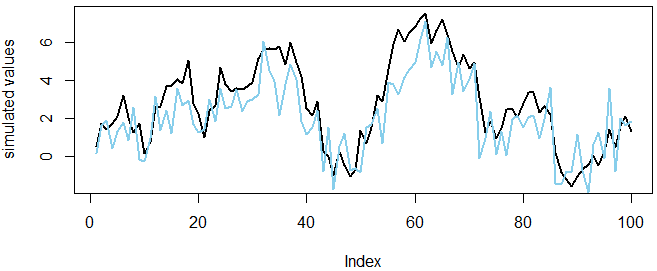
Both series are individually random walks.
In real world we don't know gamma, so need estimation based on raw data, running linear regression of one series on the other, i.e., Engle-Granger method of testing cointegration.
1.2 Statistical Tests (Augmented Dickey Fuller test)
install.packages('urca')
library('urca')
summary(ur.df(x,type="none"))
summary(ur.df(y,type="none"))
NULL: Unit root exists in the process
Reject NULL if test-statistic is smaller than critical value. Result shows test-statistic is larger than critical value at three usual sig.levels. We can't reject NULL.
Conclusion: Both series are individually unit root process.
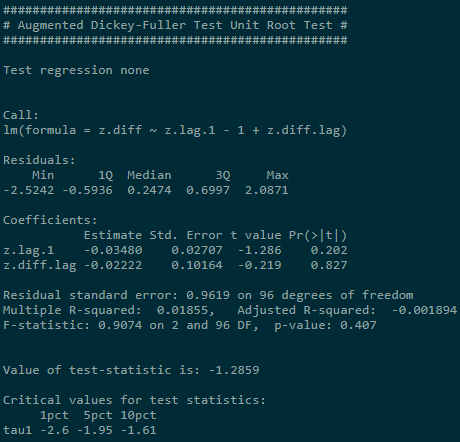
1.3 Linear Combination
z <- y - gamma * x
plot(z,type='l')
summary(ur.df(z,type="none"))
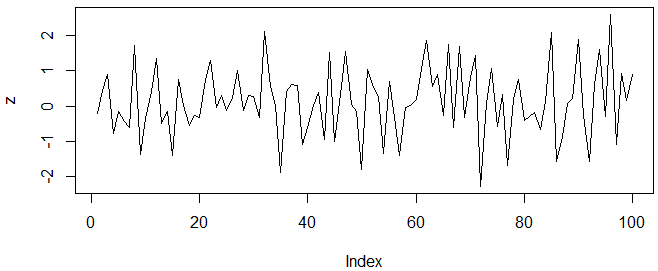
zt seems to be a white noise process and rejection of unit root if confirmed by ADF tests:
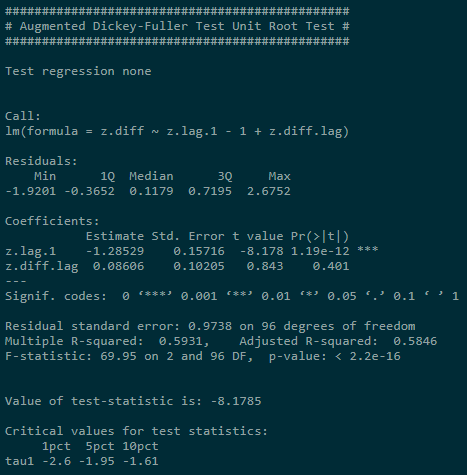
1.4 Estimate the Cointegrating Relationship using Engle-Granger method
Step 1: Run linear regression yt on xt (simple OLS estimation);
Step 2: Test residuals for the presence of a unit root.
coin <- lm(y ~ x -1) #regression without constant
coin$resid #obtain the residuals
summary(ur.df(coin$resid)) #ADF test of residuals
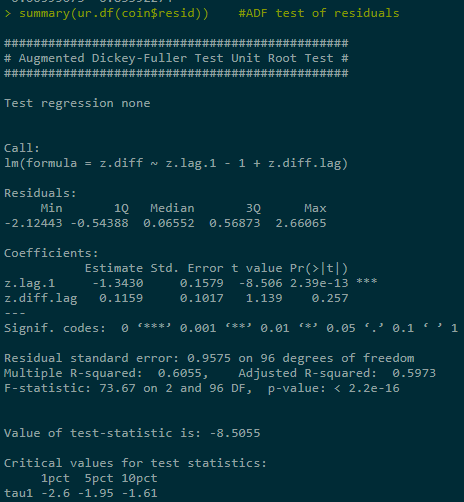
Reject NULL.
Pair trading (statistical arbitrage) exploits such cointegrating relationship, aiming to set up strategy based on the spread between two time series. If two series are cointegrated, we expect their stationary linear combination to revert to 0. By selling relatively expensive and buying cheaper one, wait for the reversion to make profit.
Intuition: Linear combination of time series (which form cointegrating relationship) is determined by underlying (long-term) economic forces, e.g., same industry companies may grow similarly; spot and forward price of financial product are bound together by no-arbitrage principle; FX rates of interlinked countries tend to move together.
2. Vector Autoregressive Model
2.1 Theory Bgs

Ai are n×n coefficient matrices for all i = 1...p;
ut is a vector white noise process (assumes lack of auto correlation, while allow contemporaneous (同时发生的) correlation between components, i.e., ut has non-diagonal covariance matrix, meaning that contemporaneous dependencies aren't modeled) with positive definite covariance matrix. Thus we can use OLS to estimate equation by equation. (叫做 reduced form VAR models)
另一种叫做 structural VAR form model, SVAR models the contemporaneous effects among variables:

Where: 
Disturbance terms are defined to be uncorrelated, thus are referred to as structural shocks.
2.2 Three-component VAR model (equity return, stock index, US Treasury bond interest rates)
2.2.1 Task: Forecast stock market index by using additional variables and identify impluse responses.
Assume: There exists a hidden long-term relationship between these three components.
2.2.2 Process:
rm(list = ls()) #clear the whole workspace
install.packages('xts');library(xts)
install.packages('vars');library('vars')
install.packages('quantmod');library('quantmod')
getSymbols('SNP', from='2012-01-02', to='2020-02-29')
getSymbols('MSFT', from='2012-01-02', to='2020-02-29')
getSymbols('DTB3', src='FRED') #3-month T-Bill interest rates
chartSeries(MSFT, theme=chartTheme('white'))
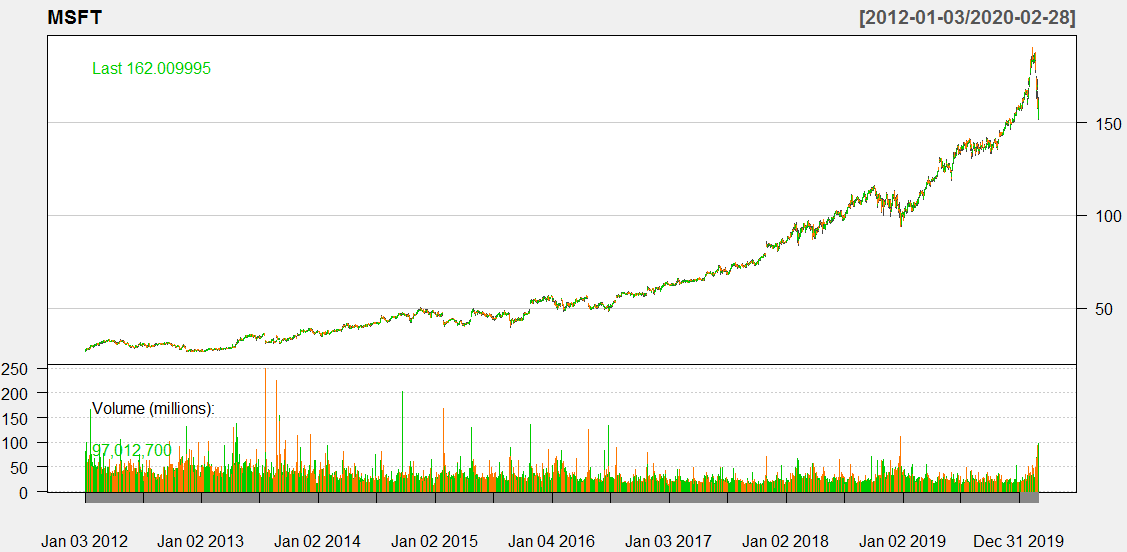
Cl(MSFT) #closing prices
Op(MSFT) #open prices
Hi(MSFT) #daily highest price
Lo(MSFT) #daily lowest price
ClCl(MSFT) #close-to-close daily return
Ad(MSFT) #daily adjusted closing price
Subset to obtain period of interests ,while the downloaded prices are supposed to be nonstationary series and should be transformed into stationary series:
#indexing time series data
DTB3.sub <- DTB3['2012-01-02/2020-02-29']
#Calculate returns from Adjusted log series
SNP.ret <- diff(log(Ad(SNP)))
MSFT.ret <- diff(log(Ad(MSFT)))
#replace NA values
DTB3.sub[is.na(DTB3.sub)] <- 0
DTB3.sub <- na.omit(DTB3.sub) # return with incomplete removed
# merge the three databases to get the same length
# innerjoin returns only rows in which one set have matching keys in the other
dataDaily <- na.omit(merge(SNP.ret,MSFT.ret,DTB3.sub), join='inner')
VAR modeling usually deals with lower frequency data, so transform data to monthly (or quarterly) frequency.
#obtain monthly data, package xts
SNP.M <- to.monthly(SNP.ret)$SNP.ret.Close
MSFT.M <- to.monthly(MSFT.ret)$MSFT.ret.Close
DTB3.M <- to.monthly(DTB3.sub)$DTB3.sub.Close
# allow a max of 4 lags
# choose the model with best(lowest Akaike Information Criterion value)
var1 <- VAR(dataDaily, lag.max=4, ic="AIC")
Or see multiple information criteria:
VARselect(dataDaily,lag.max=4)
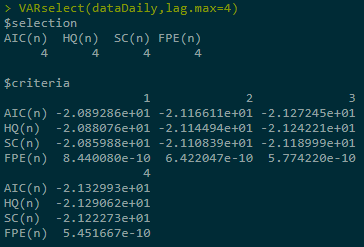
summary(var1)



coef(var1) #concise summary of the estimated variables
residuals(var1) #list of residuals (of the corresponding ~lm)
fitted(var1) #list of fitted values
Phi(var1) #coefficient matrices of VMA representation
plot(var1, plot.type='multiple') #Diagram of fit and residuals for each variables
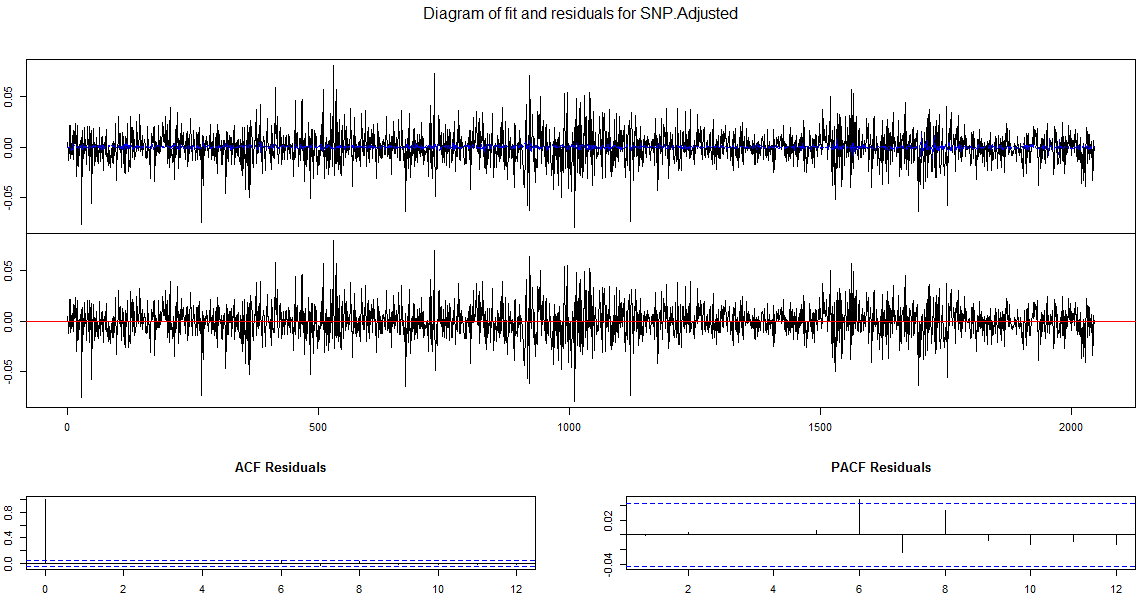
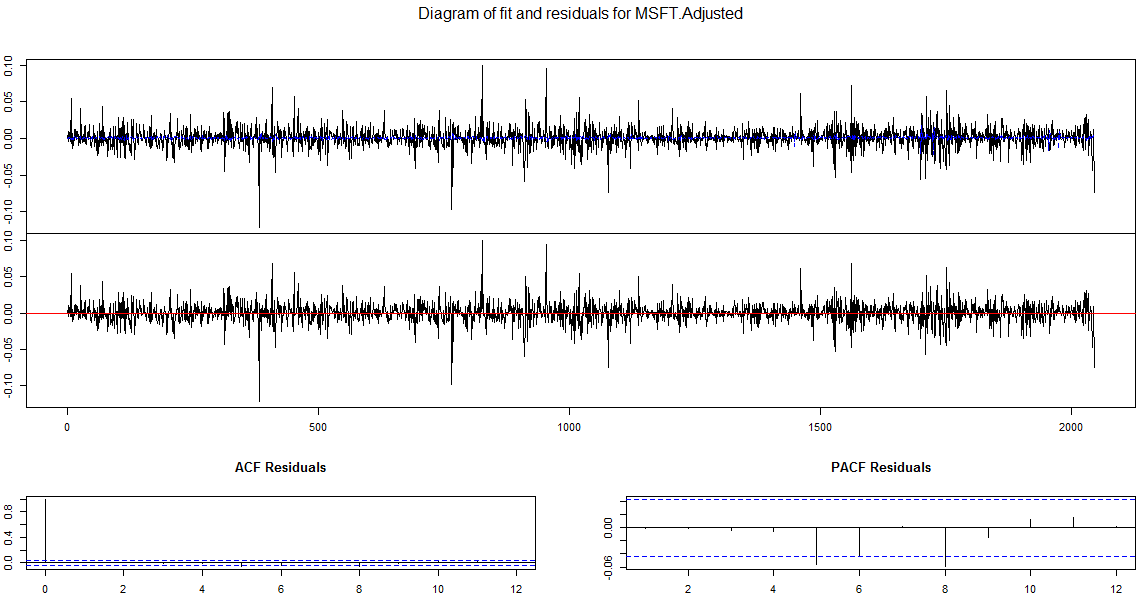
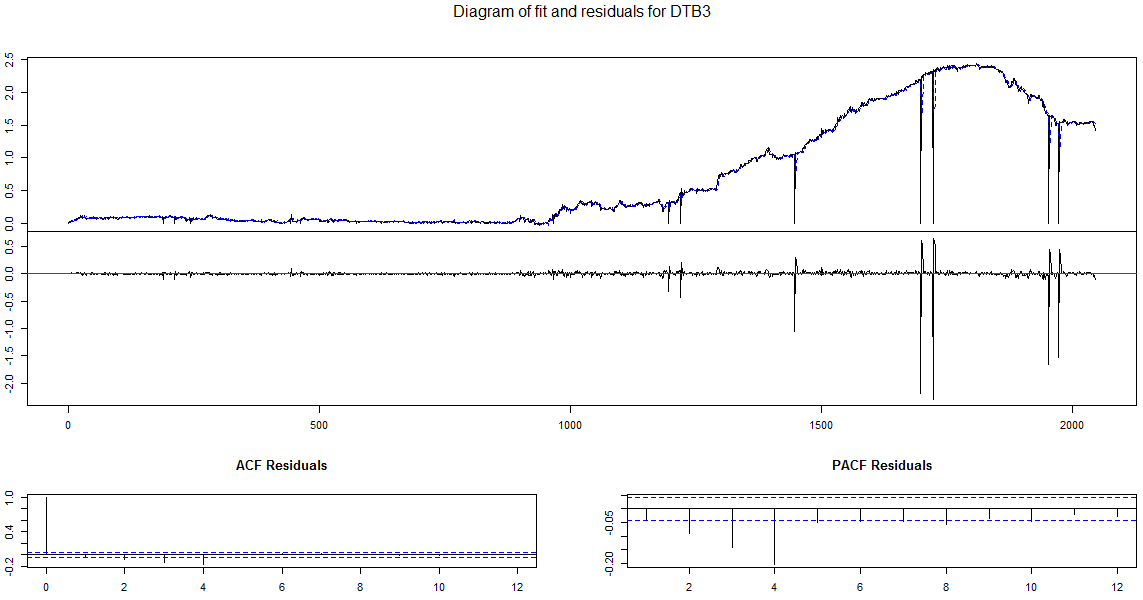
#confidence interval for bootstrapped error bands
var.irf <- irf(var1, ci=0.9)
plot(var.irf)
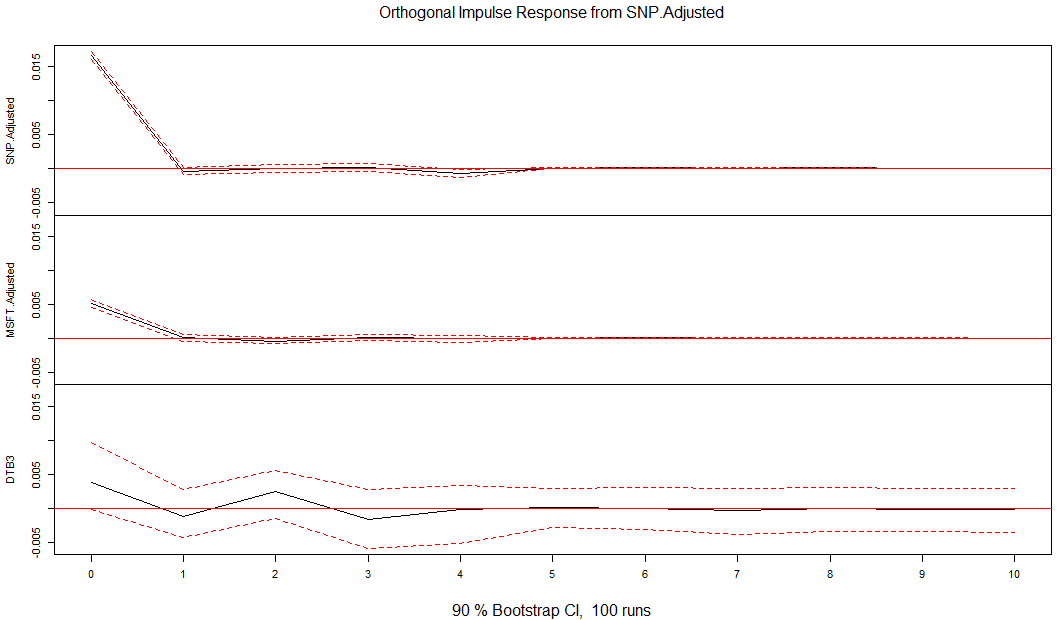
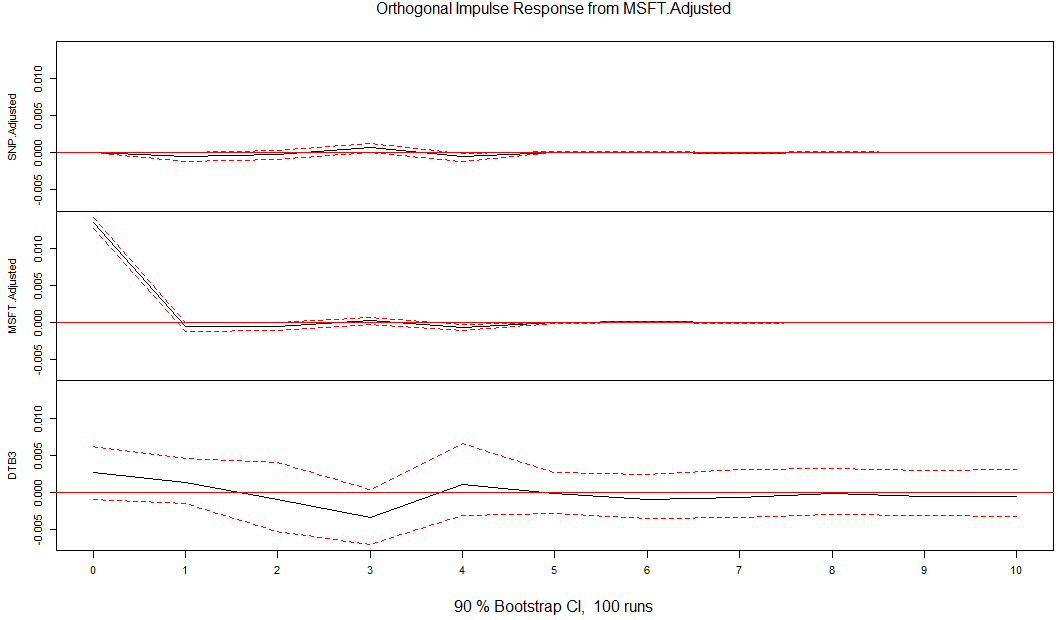
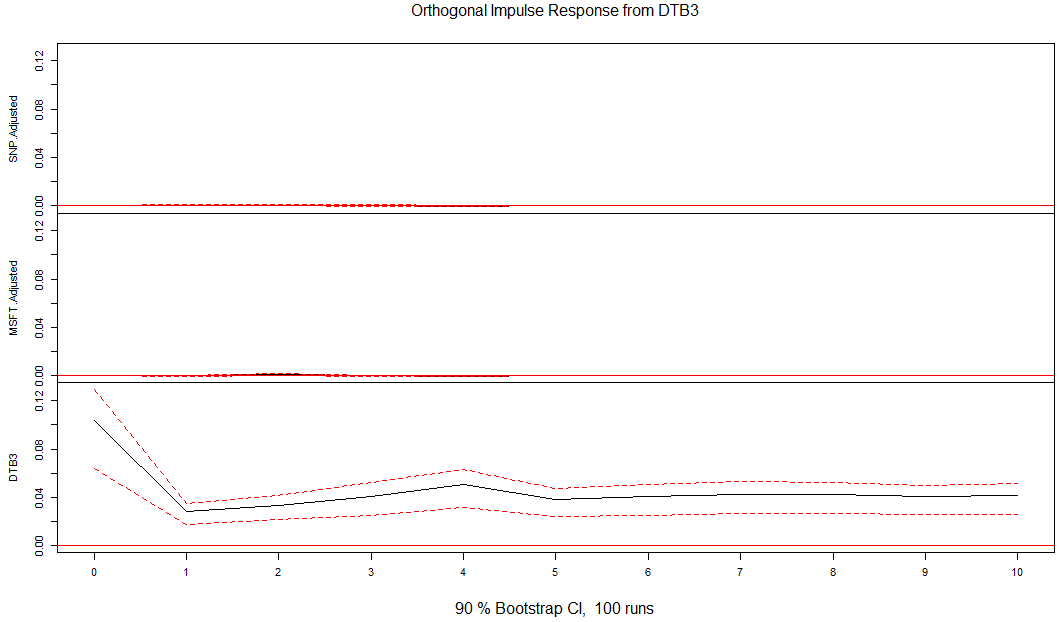
Number of required restrictions for SVAR model is K(K-1)/2, so in our case is 3.
Time Series_2_Multivariate_TBC!!!!的更多相关文章
随机推荐
- CSS——textarea多行文本框禁止拖动问题解决
文本框这样配置就好 textarea{ resize:none; }
- redis基本操作,基于StringRedisTemplate,存储,取值,设置超时时间,获取超时时间,插入list操作
@Autowired private StringRedisTemplate stringRedisTemplate; @GetMapping("/test") void test ...
- Jmeter_Http默认请求值
1.线程组->配置原件->Http请求默认值 2.作用:几个Http 请求参数都是重复的数据 3.优先级:Http请求默认值和单个Http请求数值,使用单个Http请求数值为主 举例如下: ...
- Maven____笔记摘抄
1 1.maven的作用 i.增加第三方Jar (spring-context.jar spring-aop.jar ....) ii.jar包之间的依赖关系 (spring-context.jar ...
- BinaryTree(二叉树)
我认为二叉树的递归实现体现了递归思想的一些重要性质,如果对递归的理解不够的话,想利用递归来实现是很费劲的(实际上我现在都还有些懵...),虽然会用,但一些地方不能弄清楚原因. 经过几天的学习,看了许多 ...
- 「NOI2009」植物大战僵尸
「NOI2009」植物大战僵尸 传送门 这是一道经典的最大权闭合子图问题,可以用最小割解决(不会的可以先自学一下) 具体来说,对于这道题,我们对于两个位置的植物 \(i\) 和 \(j\) ,如果 \ ...
- SystemC中文教程一
SystemC是什么 首先, SystemC不是一门新的语言,而是基于C++开发的library:因此,你所熟悉的C++知识都可以在SystemC建模时使用:理论上来说,SystemC library ...
- where、having区别
where << group by << having where筛选是在分组之前筛选,筛选完之后再group by having是分组之后再筛选,筛选完之前先g ...
- java事务/springboot事务/redis事务
java事务(数据库事务):jdbc事务--ACID springboot事务:@Transactional--ACID redis事务:命令集合 将redis事务与mysql事务对比: Mysq ...
- Caffe2 玩玩回归(Toy Regression)[5]
前言 这一节将讲述如何使用Caffe2的特征进行简单的线性回归学习.主要分为以下几步: - 生成随机数据作为模型的输入 - 用这些数据创建网络 - 自动训练模型 - 查看梯度递减的结果和学习过程中网络 ...
